
Quantitative comparisons make up a large part of the math portion of the GRE. This is good news because they are the easiest problems to improve on.
Generally, quantitative comparison Questions require much less calculating than do multiple-choice Questions. But they are trickier.
Substitution is very effective with quantitative comparison problems. But you must plug in all five major types of numbers: positives, negatives, fractions, 0, and 1. Test 0, 1, 2,–2, and 1/2, in that order.
GENERAL PRINCIPLES FOR SOLVING QUANTITATIVE COMPARISONS
The following principles can greatly simplify quantitative comparison problems.

You Can Add or Subtract the Same Term (Number) from Both Sides of a quantitative Comparison Problem.

You Can Multiply or Divide Both Sides of a quantitative Comparison Problem by the Same Positive Term (Number). (Caution: This cannot be done if the term can ever be negative or zero.)
You can think of a quantitative comparison problem as an inequality/equation. Your job is to determine whether the correct symbol with which to compare the columns is <, =, >, or that it cannot be determined. Therefore, all the rules that apply to solving inequalities apply to quantitative comparisons. That is, you can always add or subtract the same term to both columns of the problem. If the term is always positive, then you can multiply or divide both columns by it. (The term cannot be negative because it would then invert the inequality. And, of course, it cannot be zero if you are dividing.)
Example:

Don’t solve this problem by adding the fractions in each column; that would be too time consuming—the LCD is 120! Instead, merely subtract 1/5 and 1/8 from both columns:

Now 1/3 is larger than 1/4, so Column A is larger than Column B.

If there are only numbers (i.e., no variables) in a quantitative comparison problem, then “not-enough-information” cannot be the answer. Hence (D), not-enough-information, cannot be the answer to the example above.
Column A |
y>0 |
Column B |
y3+y4 |
|
y4-2y3 |
First cancel y4 columns:
Column A |
y>0 |
Column B |
y3 |
|
-2y2 |
Since y>0, we can divide both columns by y2.
Column A |
y>0 |
Column B |
y |
|
-2 |
Now, we are given that y>0. Hence, Column A is greater. The answer is (A).
Example:
Column A |
x>1 |
Column B |
|
|
|
Since x>1, x-1>0. Hence, we can multiply both columns by x(x-1) to clear fractions. They yields
Column A |
x>1 |
Column B |
x-1 |
|
x |
Subtracting x from both columns yields
Column A |
x>1 |
Column B |
-1 |
|
0 |
In this form, it is clear that Column B is larger. The answer is (B).
Example:
Column A |
n is positive integer and 0<x<1 |
Column B |
|
|
n2 |
Since we are given that n is positive, we may multiply both columns by  :
:
Column A |
|
Column B |
|
|
n2. |
Reducing yields
Column A |
|
Column B |
1/x |
|
1 |
We are also given that 0 < x < 1. So, we may multiply both columns by x to get
Column A |
Column B |
1 |
x |
But again, we know that 0 < x < 1. Hence, Column A is larger.

You Must Be Certain That the quantity You Are Multiplying or Dividing by Can Never Be Zero or Negative. (There are no restrictions on adding or subtracting.)
The following example illustrates the false results that can occur if you don’t guarantee that the number you are multiplying or dividing by is positive.
Column A |
0 ≤ x < 1 |
Column B |
x3 |
|
x2 |
Solution (Invalid): Dividing both columns by x2 yields
Column A |
Column B |
x |
1 |
We are given that x < 1, so Column B is larger. But this is a false result because when x = 0, the two original columns are equal:
Column A |
Column B |
03 = 0 |
02 = 0 |
Hence, the answer is actually (D), not-enough-information to decide.

Don’t Cancel Willy-Nilly.
Some people are tempted to cancel the x2s from both columns of the following problem:
Column A |
Column B |
x2 + 4x – 6 |
6 + 4x – x2 |
You cannot cancel the x2s from both columns because they do not have the same sign. In Column A, x2 is positive. Whereas in Column B, it is negative.

You Can Square Both Sides of a quantitative Comparison Problem to Eliminate Square Roots.
Example:

Squaring both columns yields


Reducing gives

Now, clearly Column A is larger,
Example:

Multiplying both columns by 15 to clear fractions yields

Squaring both columns yields
Column A |
Column B |
25 · 2 |
36 |
Performing the multiplication in Column A yields
Column A |
Column B |
50 |
36 |
Hence, Column A is larger, and the answer is (A).
SUBSTITUTION (Special Cases)
We already studied this method in the section Substitution. Here, we will practice more and learn a couple of special cases.

A. In a problem with two variables, say, x and y, you must check the case in which x = y. (This often gives a double case.)
Example:
Column A |
x and y are positive. |
Column B |
Average of x and y |
|
Average of x3 and y3 |
Let x = y = 1. Then Column A becomes  = 1. And Column B becomes
= 1. And Column B becomes  . = 1. In this case, the columns are equal. But if x = y = 2, then Column A becomes
. = 1. In this case, the columns are equal. But if x = y = 2, then Column A becomes  = 2 and Column B becomes
= 2 and Column B becomes  = 8. In this case, the columns are unequal. This is a double case and therefore the answer is (D).
= 8. In this case, the columns are unequal. This is a double case and therefore the answer is (D).
Column A |
x and y are integers greater than or equal to 1. |
Column B |
2x+y |
|
2x+ 2y |
If x ≠ y, then Column A is larger than Column B. (Plug in a few numbers until you are convinced.) But if x = y = 1, then the columns are equal: 2x + y = 21 + 1 = 22 = 4 and 2x + 2y = 21 + 21 = 4. Hence, there is not enough information to decide.

B. When you are given x < 0, you must plug in negative whole numbers, negative fractions, and –1. (Choose the numbers –1, –2, and –1/2, in that order.)
Example:
|
Column A |
k < 0 |
Column B |
|
|
|
0 |
If k is –1 or –2, then Column A is larger since it is a product of squares. But if k = –1/2, then the two  . Hence, there is not enough information to decide and the answer is (D).
. Hence, there is not enough information to decide and the answer is (D).

C. Sometimes you have to plug in the first three numbers (but never more than three) from a class of numbers.
Example:
x is both an integer and greater than 1. Let [x] stand for the smallest positive integer factor of x not equal to 1.
Column A |
Column B |
[x] |
[x3] |
Choose x = 2, 3, and 4. If x = 2, then [x] = 2 and [x3] = [8] = 2. So for this choice of x, the two columns are equal. If x = 3, then [x] = 3 and [x3] = [27] = 3, again the columns are equal. Finally, If x = 4, then [x] = 2 and [x3] = [64] = 2, still again the columns are equal. Hence, the answer is (C). Note, there is no need to check x – 5. The writers of the GRE do not change the results after the third number.
 Easy
Easy
1. |
Column A |
n is a positive integer |
Column B |
|
n |
|
The sum of two integers whose product is n |
2. |
Column A |
0 < x < 1 |
Column B |
|
x2 |
|
x |
3. |
Column A |
|
Column B |
|
The count of the numbers between 100 and 300 that are divisible by both 5 and 6 |
|
The count of the numbers between 100 and 300 that are divisible by either 5 and 6 |
 Medium
Medium
4. |
Column A |
In the retangular coordinate system shown, points A and E lie on the x- axis and points B and D lie on the y-axis. point C is the midpoint of the line AB, and point F is the midpoint of the line DE. |
Column B |
|
The slope of the line AB |
|
The slope of the line DE |
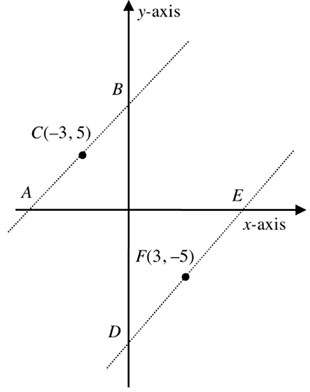
5. |
Column A |
x=3.635 · 1016 |
Column B |
|
|
|
|
6. |
Column A |
|
Column B |
|
a |
|
b |
7. |
Column A |
|x| + |y| = 2 and x + y = 0. |
Column B |
|
x |
|
y |
8. |
Column A |
(4 – 5x)2 = 1 |
Column B |
|
(4 – 5x) + (4 – 5x)2 |
|
1 |
9. |
Column A |
The ratio of x to y is 3 : 4, and the ratio of x + 7 to y + 7 is 4 : 5. |
Column B |
|
|
|
|
10. |
Column A |
x and y are two numbers |
Column B |
|
The product of x and y |
|
The product of 80% of x and 125% of y |
11. |
Column A |
ABC and DEF are right triangles. Each side of ΔABC is twice the length of the corresponding side of ΔDEF |
Column B |
|
|
|
|
12. |
Column A |
The nth term of the sequence a1, a2, a3, … , an is defined as an = –(an-1). The first term a1 equals –1. |
Column B |
|
a5 |
|
1 |
13. |
Column A |
Everyone who passes the test will be awarded a degree. The probability that Tom passes the test is 0.5, and the probability that John passes the test is 0.4. The two events are independent of each other. |
Column B |
|
The probability that both Tom and John get the degree |
|
The probability that at least one of them gets the degree |
14. |
Column A |
|
Column B |
|
The difference between two angles of a triangle |
|
179.5° |
15. |
Column A |
2x + 1 > 3x + 2 and 5x + 2 > 4x |
Column B |
|
x |
|
1 |
16. |
Column A |
|
Column B |
|
k |
|
1/3 |
17. |
Column A |
The average of a set of six positive numbers is 30. |
Column B |
|
The average of the numbers in the set after replacing the smallest number in the set with 0 |
|
The average of the remaining numbers in the set after removing the smallest number from the set |
18. |
Column A |
In the figure, ABCD and BECD are parallelogrames. |
Column B |
|
Area parallelogram ABCD |
|
Area parallelogram BCED |
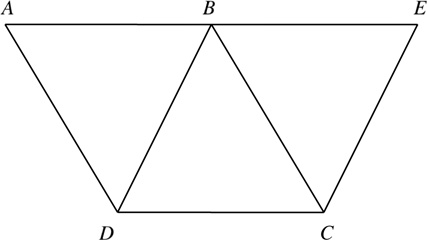
 Very Hard
Very Hard
19. |
Column A |
A set has exactly five consecutive positive integers. |
Column B |
|
The percentage decrease in the average of the numbers when one of the numbers is dropped from the set |
|
20% |
20. |
Column A |
A tank is filled with x pounds of wheat. The tank has a hole at the bottom and each day 1% of the wheat is lost from the tank through the hole. |
Column B |
|
Percentage of wheat lost in the first three days |
|
3% |
Answers and Solutions to Problem Set F
 Easy
Easy
1. Suppose n = 6. Now, the factors of 6 are 6 and 1, and 2 and 3.
In the first case, factors 6 and 1 sum to 7 (= 6 + 1), which is greater than 6 (= Column A). Here, Column B is greater.
In the second case, the factors 2 and 3 sum to 5 (= 2 + 3), which is less than 6 (= Column A). Here, Column A is greater. This is a double case, and therefore the answer is (D).
2. Since 0 < x < 1, we know that x is positive. Now, multiplying both sides of the inequality 0 < x < 1 by x yields
0 < x2 < x
Hence, Column B is greater than Column A, and the answer is (B).
3. The least common multiple of 5 and 6 is the product of the two (since 5 and 6 have no common factors), which is 5 · 6 = 30. Hence, if a number is divisible by both 5 and 6, it must be a multiple of 30. For example, the numbers 30, 60, 90, … are divisible by both 5 and 6.
Now, if a number is divisible by either 5 or 6, the number must be a multiple of at least one of them. Since there are more multiples of 5 and 6 than there are of 30 between 100 and 300, the count in Column B is greater than the count in Column A.
The answer is (B).
 Medium
Medium
4. Let the coordinate representations of points A and E (which are on the x-axis) be (a, 0), and (e, 0), respectively. Also, let the coordinates of the points B and D (which are on the y-axis) be (0, b) and (0, d), respectively.
The formula for the midpoint of two points (x1, y1) and(x2, y2) in a coordinate system is 
Hence, the midpoint of AB is  = C(–3, 5). Equating the x- and y-coordinates on both sides yields a/2 = –3 and b/2 = 5. Solving for a and b yields a = –6 and b = 10.
= C(–3, 5). Equating the x- and y-coordinates on both sides yields a/2 = –3 and b/2 = 5. Solving for a and b yields a = –6 and b = 10.
Similarly, the midpoint of DE is  = F(3, –5). Equating the x- and y-coordinates on both sides yields e/2 = 3 and d/2 = –5. Solving for e and d yields e = 6 and d = 10.
= F(3, –5). Equating the x- and y-coordinates on both sides yields e/2 = 3 and d/2 = –5. Solving for e and d yields e = 6 and d = 10.
The slope of a line through two points (x1, y1 and (x2, y2) in a coordinate system is 
Hence, Column A, which is the slope of AB, equals 
Column B, which is the slope of DE, equals  .
.
Since both columns equal 5/3, the answer is (C).
5. Since x is a large positive number, both x + 1 and x – 1 are positive. Hence, we can clear fractions by multiplying both columns by (x + 1)(x – 1), which yields
(x + 1)2 |
(x – 1)2 |
Performing the multiplication yields
x2 + 2x + 1 |
(x2 – 2x + 1) |
Subtracting x2 and 1 from both columns yields
2x |
–2x |
Since x is a positive number, Column A is positive and Column B is negative.
Since all positive numbers are greater than all negative numbers, Column A is greater than Column B and the answer is (A).
6. Multiplying the given inequalities by 10 yields
10a + b > 0
10b + a < 0
Multiplying the second inequality by –1 and flipping the direction of the inequality yields
10a + b > 0
-a + 10b > 0
Adding these inequalities yields
9a – 9b < 0
Adding 9b to both sides of the inequality yields
9a > 9b
Finally, dividing both sides of the inequality by 9 yields
a > b
Hence, Column A is greater than Column B. The answer is (A).
7. Suppose x = 1 and y = 1. The |x| + |y| = |1| + |–1| = 1 + 1 = 2, and x + y = 1 + (–1) =0. Hence, x = 1 and y = –1 is a solution of the system of equations, and here x is greater than y.
Now, suppose x = –1 and y = 1. Then |x| + |y| = |–1| + |1| = 1 + 1 = 2, and x + y = –1 + 1 = 0. Hence, x = –1 and y = 1 is another solution of the system of equations, and here x is less than y.
Thus, we have a double case, and the answer is (D).
8. (4 – 5x)2 equals 1 when either 4 – 5x = –1 or + 1. If 4 – 5x equals –1, then (4 – 5x) + (4 – 5x)2 = –1 + 1 =0; and if 4 – 5x equals 1, then (4 – 5x) + (4 – 5x)2 = 1 + 1 = 2. In the first case, Column A is less than Column B; and in the second case, Column B is less than Column A. Hence, we have a double case, and the answer is (D).
9. Forming the two ratios yields  and =
and =  . Let’s solve this system of equations by the substitution method. Multiplying the first equation by y yields x = 3y/4. Substituting this into the second equation yields
. Let’s solve this system of equations by the substitution method. Multiplying the first equation by y yields x = 3y/4. Substituting this into the second equation yields  . Cross-multiplying yields
. Cross-multiplying yields
5(3y/4 + 7) = 4(y + 7)
15y/4 + 35 = 4y + 28
15y/4 – 4y = 28 – 35
-y/4 = –7
y = 28
and  .
.
Plugging these values for x and y into the expression in Column A,  yields
yields

Hence, the answer is (C).
10. Column A: The product of x and y is xy.
Column B : 80% of x is 
And 125% of y is 
The product of the two is  = xy = Column A.
= xy = Column A.
Hence, the columns are equal, and the answer is (C).
11. We are given that each side of triangle ABC is twice the length of the corresponding side of triangle DEF. Hence, each leg of triangle ABC must be twice the length of the corresponding leg in triangle DEF. The formula for the area of a right triangle is 1/2 • (product of the measures of the two legs). Hence,
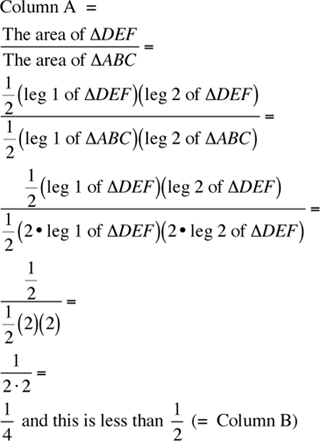
Hence, the answer is (B).
12. The rule for the sequence is an = (–an–1). Putting n = 2 and 3 in the rule yields
a2 = –(a2–1) = –a1 = –(–1) = 1 (given that a1 = –1)
a3 = –(a3–1) = –a2 = –1
Similarly, we get that each even numbered term (when n is even) equals 1 and each odd numbered term (when n is odd) equals –1. Since a5 is an odd numbered term, it equals –1. Hence, Column A equals –1 and is less than 1 (= Column B). The answer is (B).
13. The case of both Tom and John getting a degree is just one of the cases in which at least one of them gets the degree (Column A is one of the cases of Column B). Hence, the probability of the former is less than the probability of the later (Column B is greater). Also, the probability of the remaining case (exactly one of the two passing) is not zero. So, Column A cannot equal Column B. The answer is (B).
14. Suppose the angles of the triangle measure 179.8°, 0.1°, and 0.1°. Then the difference between the first two angles of the triangle is 179.8 – 0.1 = 179.7 > Column B and the difference between the last two angles is 0.1 – 0.1 = 0 < Column B.
Hence, we have a double case, and the answer is (D).
15. We are given the two inequalities
2x + 1 > 3x + 2
5x + 2 > 4x
Subtracting 2x + 2 from both sides of the top inequality and subtracting 4x + 2 from both sides of the bottom inequality yields
–1 > x
x > –2
Combining these inequalities yields –1 > x > –2. Since any number between –1 and –2 is less than 1, Column B is greater than Column A. The answer is (B).
16. The given equation is  . Forming the three equations yields l = (m + n)k, m = (n + l)k, n = (l + m)k. Summing these three equations yields
. Forming the three equations yields l = (m + n)k, m = (n + l)k, n = (l + m)k. Summing these three equations yields
l + m + n = (m + n)k + (n + l)k + (l + m)k
= k[(m + n) + (n + l) + (l + m)]
= k(m + n + n + l + l + m)
= k(2m + 2n + 2l)
= 2k(m + n + l)
1 = 2k by canceling m + n + l from each side
1/2 = k
Hence, Column A equals 1/2. Since 1/2 is greater than 1/3, Column A is greater than Column B, and the answer is (A).
17. Let a, b, c, d, e, and f be the numbers in the set, and let f be the smallest number in the set.
When the smallest number (f) in the set is replaced by 0, the numbers in the set are a, b, c, d, e, and 0. Column A equals the average of these six numbers, which equals  .
.
Instead, if the smallest number in the set is removed, the remaining numbers in the set would be a, b, c, d, and e. Now there are only 5 numbers in the set. Hence, Column B, which equals the average of the remaining numbers (five numbers) in the set, equals  .
.
Since all the numbers in the set are positive (given), the sum of the five numbers a + b + c + d + e is also positive. Note that dividing a positive number by 5 yields a greater result than dividing it by 6. Hence,  is greater than
is greater than  . Thus, Column B is greater than Column A, and the answer
. Thus, Column B is greater than Column A, and the answer
18. We know that a diagonal of a parallelogram cuts the parallelogram into two triangles of equal area. Since BD is a diagonal of parallelogram ABCD, the area of the parallelogram equals twice the area of either of the two equal triangles ΔABD or ΔDBC. Hence, Column A = 2(area of ΔDBC).
Similarly, since BC is a diagonal of parallelogram BECD, the area of the parallelogram BECD is 2(area of ΔDBC).
Thus, both columns equal 2(area of ΔDBC), and the answer is (C).
19. The average of the five consecutive positive integers, say, a, a + 1, a + 2, a + 3, and a + 4 is
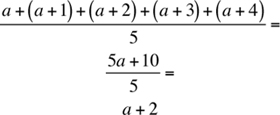
The average decrease is a maximum when the greatest number in the set is dropped. Hence, after dropping a + 4, the average of the remaining numbers a, a + 1, a + 2, and a + 3 is
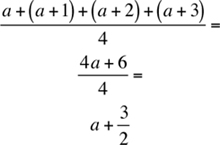
The percentage decrease in the average is

The percentage is a maximum when a takes the minimum possible value. Since a is a positive integer, the minimum value of a is 1. Hence, the maximum possible percentage equals

Hence, the maximum possible value of Column A is 16.66%, which is less than Column B. Hence, the answer is (B).
20. We are given that each day 1% of the remaining wheat in the tank is lost. The initial content in the tank is x pounds. By the end of the first day, the content remaining is
(Initial content)(l – Loss percent/100) = x(1 – 1/100) = 0.99x
Similarly, the content remaining after the end of the second day is 0.99x(1 – 1/100) = (0.99)(0.99)x; and by the end of the third day, the content remaining is (0.99)(0.99)(0.99)x. Hence, Column A, which equals the net loss percentage in the three consecutive days, is

Hence, Column A < Column B and the answer is (B).